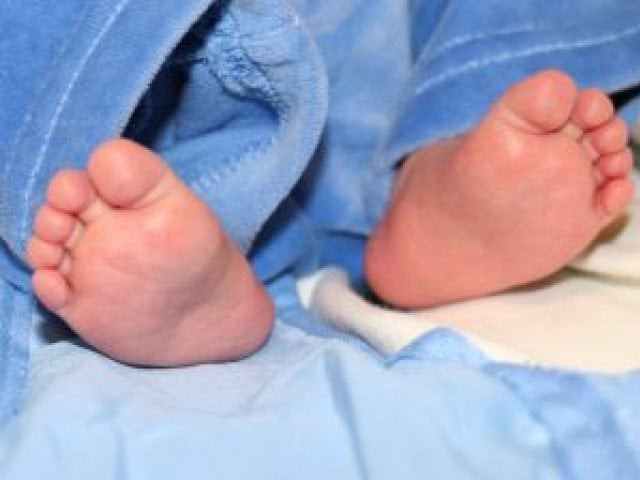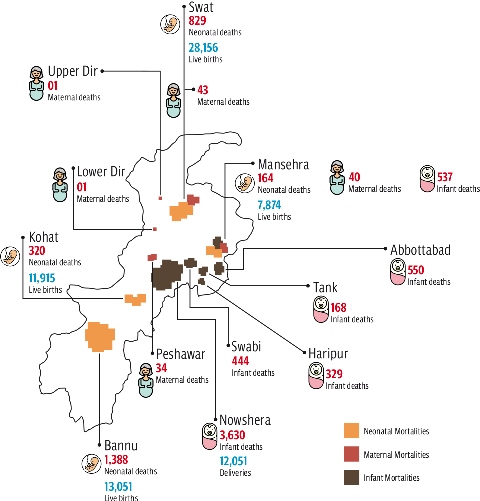Reducing neonatal mortality in K-P – a job far from done
Neonatal Mortality Rate remained high across the province, with 17 deaths occurring per 1,000 live births

PHOTO: EXPRESS
Five years into the office, the PTI government still claims to be focusing on improving the sector. Statistics, however, paint a different picture.
According to the annual report of the District Health Information System (DHIS), in 2018, Neonatal Mortality Rate (NMR) remained high across the province, with 17 deaths occurring per 1,000 live births – that too at governmental health facilities.
Neonatal ICU established at Koohi Goth Hospital
The DHIS data – which is collected from every governmental health facility in the province – shows that 3,836 newborn babies died throughout K-P last year, with cases reported from almost every district except for Kohistan and Hangu.
The highest number of infant deaths have been reported in district Bannu, with 1,388 infant deaths occurring out of a total of 13,051 live births.
Officials say that the government has been making efforts to minimise neonatal, infant and maternal deaths. They added that in order to bring about improvements in the health sector, the K-P government increased its health budget from Rs55 billion for 2016-17 to Rs65.7 billion for the fiscal year 2017-18.
Nonetheless, recent statistics show that except for two or three districts of K-P, a lot more efforts are required to improve maternal and children’s health conditions in the province.
Depressing figures
Neonatal death is a term used for the demise of a baby within the first four weeks of its life. According to the World Health Organization (WHO), in developing countries, nearly half of all mothers and newborns do not receive skilled care during and immediately after birth.
The WHO also stated the three major causes of neonatal deaths worldwide, comprising infections (36%, which includes sepsis/pneumonia, tetanus and diarrhoea), pre-term (28%), and birth asphyxia (23%).

The data collected by the provincial government of K-P revealed that 1,388 neonatal deaths were confirmed out of a total of 13,051 live births in Bannu, followed by 829 deaths in Swat per 28,156 live births. In Kohat, 320 deaths occurred per 11,915 live births, while there were 164 neonatal death in Mansehra as against 7,874 live births. Similarly, in Lower Dir, there were 229 deaths out of a total 13,578 live births.
According to the report, out of a total of 16,865 live births, 277 infants couldn’t survive, while in Chitral, the number of infants dying immediately after or within the first weeks of their lives was 113 out of a total 7397 live births.
In Buner, 111 neonatal deaths occurred per 9,243 live births, 85 deaths out of 9,046 live births in Haripur, 63 out of 9,300 live births in Abbottabad, while some 84 neonatal deaths were confirmed in district Swabi out of a total of 10,173 live births.
World's tiniest baby survives against all odds
The report further detailed that throughout 2018, thirty-two infants died per 6,460 live births in Battagram, two infants died out of 459 live births in Tor Ghar, 62 deaths out of 14,866 were reported in Mardan, 27 out of 8,130 in Upper Dir, eight out of 4,653 in Shangla, 22 infants died per 13,235 live births in Peshawar, nine failed to survive out of a total of 9,220 live births in Charsadda, five per 5,732 live births in Nowshera, three out of 5,320 live births in Karak, one out of 3,067 live births in Tank, one out of 3,340 live births in Dera Ismail Khan, and similarly, one out of 3,924 live births in Lakki Marwat.
Kohistan and Hangu were exceptions, where not even a single death has been reported. Some 984 live births were reported in Kohistan while the later had 3,709 live births.
Maternal mortalities
The World Health Organisation shows that approximately 830 women die every day from preventable causes related to pregnancy and childbirth, and 99% of all maternal deaths occur in developing countries.
Studies show that women die during childbirth, and following their pregnancies, due to complications which are preventable or treatable. The major complications that account for nearly 75% of all maternal deaths include severe bleeding (mostly bleeding after childbirth), infections (usually after childbirth), high blood pressure during pregnancy (pre-eclampsia and eclampsia), complications from delivery and unsafe abortion.
According to the DHIS report, in 2018, the Maternal Mortality Rate (MMR) in K-P was 167 per 10,0000 cases at government health facilities, where 383 women died out of a total of 22,8936 deliveries.
Maternal deaths were reported by lady health workers during pregnancy or deliveries, with the highest figure reported from district Nowshera, where 55 mothers died during deliveries by skilled persons.
In Swat, forty-three women passed away during deliveries carried out by skilled persons, followed by 40 in Mansehra, 34 in Peshawar, 30 in Mardan, 29 in Abbottabad, 21 in Dera Ismail Khan, 20 in Bannu, 18 in Charsadda, 17 in Shangla, 11 each in Kohat and Haripur, eight each in Tank, Karak and Swabi, five in Malakand, four in Battagram, three in Lakki Marwat, two in Upper Dir and one in Lower Dir.
Not even a single case has been reported from Kohistan, Tor Ghar and Hangu.
Cases of infant mortalities
Infant mortality refers to deaths of children less than one year of age, while Infant Mortality Rate (IMR) is the number of deaths of children under one year of age per 1,000 live births. According to studies, the leading causes of infant mortality include birth asphyxia, pneumonia, term birth complications, diarrhoea, malaria, measles and malnutrition.
Per the DHIS report, a total of 7,815 infants died during 22,8936 deliveries carried out by skilled persons, with rate of 34 infant deaths per 10,000 live birth. Akin to maternal deaths, the highest number of infant deaths was reported from district Nowshera, where some 3,630 infants died during 12,051 deliveries, followed by Swabi with 444 deaths, Tank with 168, and Mansehra with 537 deaths.
The report also shared details of Abbottabad where 550 deaths were reported, followed by Kohat with 103 deaths, Buner with 119, Haripur with 329, Upper Dir with 36, Karak with 105, Peshawar with 526, Shangla with 42, Chitral with 103, Lakki Marwat with 45, Swat with 391, Battagram with 18, Charsadda with 210, Bannu with 118, Malakand with 102, Mardan with 158, and Dera Ismail Khan with 81 deaths.
The report revealed that not even a single case of infant mortality was reported from Kohistan, Toor Ghar, Hangu and Lower Dir.













COMMENTS
Comments are moderated and generally will be posted if they are on-topic and not abusive.
For more information, please see our Comments FAQ